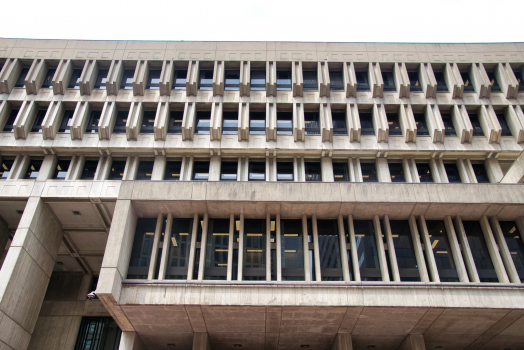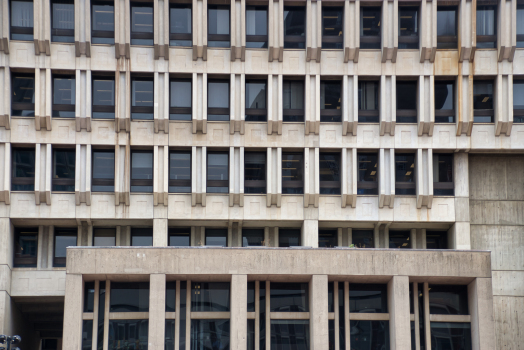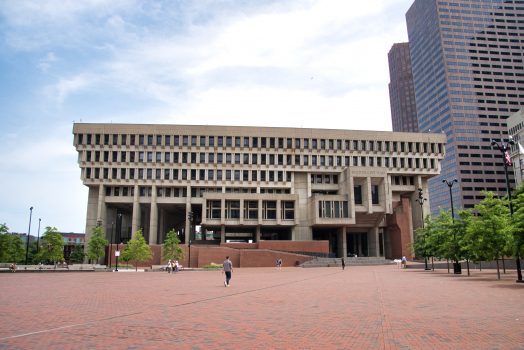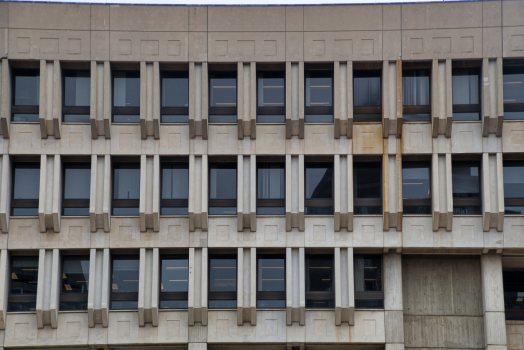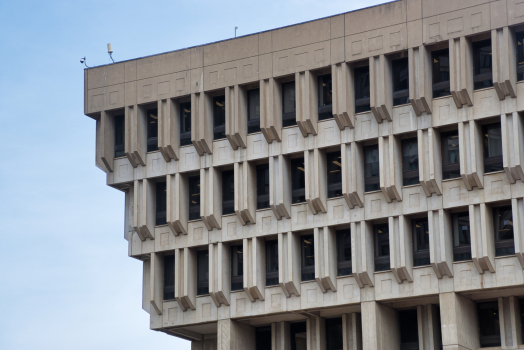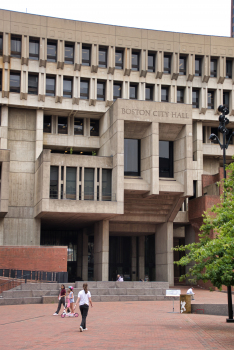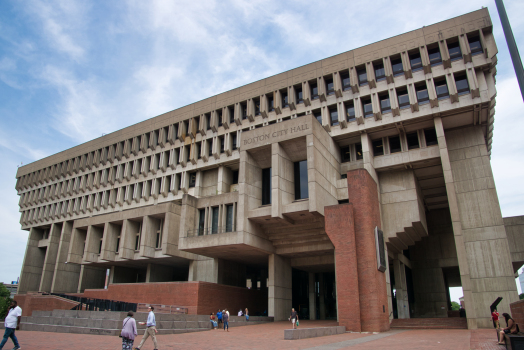General Information
Project Type
| Structure: |
Frame |
|---|---|
| Function / usage: |
City or town hall |
| Architectural style: |
Brutalist |
| Material: |
Reinforced concrete structure |
Location
| Location: |
Boston, Suffolk County, Massachusetts, USA |
|---|---|
| Address: | 1 City Hall Square |
| Coordinates: | 42° 21' 37.42" N 71° 3' 28.76" W |
Technical Information
Dimensions
| number of floors (above ground) | 11 |
Materials
| façade |
brick
|
|---|---|
| building structure |
reinforced concrete
|
Excerpt from Wikipedia
Boston City Hall is the seat of city government of Boston, Massachusetts. It includes the offices of the mayor of Boston and the Boston City Council. The current hall was built in 1968 to assume the functions of the Old City Hall.
It is a controversial and prominent example of Brutalist architecture. It was designed by Kallmann McKinnell & Knowles (architects) with Campbell, Aldrich & Nulty (architects) and LeMessurier Consultants (engineers).
Together with the surrounding plaza, City Hall is part of the Government Center complex, a major urban redesign effort in the 1960s.
The building has been subject to nearly-universal public condemnation, and is often called one of the world's ugliest buildings. Calls for the structure to be demolished have been regular since before construction was even finished. However, architects and critics considered it excellent work, with one poll finding architects describe Boston City Hall as one of the ten proudest achievements of American architecture.
Design
Boston City Hall was designed by Gerhard Kallmann, a Columbia University professor, and Michael McKinnell, a Columbia graduate student, (who co-founded Kallmann McKinnell & Knowles) who won an international, two-stage competition in 1962. Their design, selected from 256 entries by a jury of prominent architects and businessmen, departed from the more conventional designs of most of the other entries (typified by pure geometrical forms clad with sleek curtain walls) to introduce an articulated structure that expressed the internal functions of the buildings in rugged, cantilevered concrete forms. Hovering over the broad brick plaza, the City Hall was designed to create an open and accessible place for the city's government, with the most heavily used public activities all located on the lower levels directly connected to the plaza. The major civic spaces, including the Council chamber, library, and Mayor's office, were one level up, and the administrative offices were housed above these, behind the repetitive brackets of the top floors.
At a time that monumentality was seen as an appropriate attribute for governmental architecture, the architects sought to create a bold statement of modern civic democracy, placed within the historic city of Boston. While the architects looked to precedents by Le Corbusier, especially the monastery of Sainte Marie de La Tourette, with its cantilevered upper floors, exposed concrete structure, and its similar interpretation of public and private spaces, they also drew from the example of Medieval and Renaissance Italian town halls and public spaces, as well as from the bold granite structures of 19th-century Boston (including Alexander Parris' Quincy Market immediately to the east).
Many of the elements in the design have been seen as abstractions of classical design elements, such as the coffers and the architrave above the concrete columns. Kallmann, McKinnell, and Knowles collaborated with two other Boston architectural firms and one engineering firm to form the "Architects and Engineers for the Boston City Hall" as the entity responsible for construction, which took place from 1963 to 1968.
The architects designed City Hall as divided into three sections, aesthetically and also by use. The lowest portion of the building, the brick-faced base, which is partially built into a hillside, consists of four levels of the departments of city government, where the public has wide access. The brick largely transfers over to the exterior of this section, and it is joined by materials such as quarry tile inside. The use of these terra cotta products relates to the building's location on one of the original slopes of Boston, expressed in the open, brick-paved plaza, and also to historic Boston's brick architecture, seen in the adjoining Sears Crescent block and the Blackstone Block buildings across Congress Street.
The intermediate portion of City Hall houses the public officials: the Mayor, the City Council members, and the Council Chamber. The large scale and the protrusion of these interior spaces on the outside, instead of burying them deep within the buildin, reveal the important public functions to the passers-by and create a visual and symbolic connection between the city and its government. The effect is of a small city of concrete-sheltered structures cantilevered above the plaza: large forms that house important civic activities. The cantilevers are supported by exterior columns, spaced alternately at 14-foot-4-inch (4.37 m) and 28-foot-8-inch (8.74 m), which are steel-reinforced.
The upper stories contain the city's office space, which are used by civil servants not visited frequently by the public, such as the administrative and planning departments. The bureaucratic nature is reflected in the standardized window patterns, separated by pre-cast concrete fins, with an open office plan typical of modern office buildings. (The subsequent enclosure of much of this space into isolated offices contributed to the ventilation problems of those floors.)
The top of the brick base was designed as an elevated courtyard melding the fourth floor of the city hall with the plaza. Security concerns caused city officials in recent years to block access to the courtyard and the outdoor stairways to Congress Street and the plaza. The courtyard is occasionally opened up for events (such as the celebration of the Boston Celtics championship in 1986). After 9/11, security was further increased. The north entrance, facing the plaza, was barricaded with jersey barriers and bicycle racks. All visitors entering the front and the back entrances must pass through metal detectors.
City Hall was constructed by using mainly cast-in-place and precast Portland cement concrete and some masonry. About half of the concrete used in the building was precast (roughly 22,000 separate components, and the other half was poured-in-place concrete. All of the concrete in the structure, except that of the columns, is mixed with a light, coarse rock. While the majority of the building is created using concrete, precast and poured-in-place concrete are distinguishable by their different colors and textures. For example, cast-in-place elements are coarse and grainy textured because the concrete was poured into fir wood frames to mold it, and precast elements, such as trusses and supports, were set in steel molds to gain smooth, clean surfaces. This distinction can also be seen in the fact that the exterior poured-in-place pieces are of type I cement, a lightly colored cement, while the exterior precast components use type II cement, a dark colored cement. The base of the building is dark with brick, Welsh quarry tiles, mahogany walls, and darker concrete. As the building ascends, the overall color lightens, as lighter concrete is used.
Reception
Public response to Boston City Hall remains sharply controversial. Arguments for and against the structure's continued existence continue to provoke strong counter-arguments from politicians, local press, design professionals, and the general public.
Positive
While assessment of the building's architecture has followed the vagaries of architectural style, the building was acclaimed by some architects as well as by the American Institute of Architects, which gave the building its Honor Award in 1969. City Hall was awarded two stars by the Michelin Green Guide, which wrote that the building "has been one of Boston's controversial architectural statements since its completion in 1968."
Representative of its acclaim was the opinion of The New York Times critic Ada Louise Huxtable, who wrote that "in this focal building Boston sought, and got, excellence." Historian Walter Muir Whitehill wrote that "it is as fine a building for its time and place as Boston has ever produce. Traditionalists who long for a revival of Bulfinch simply do not realize that one does not achieve a handsome monster either by enlarging, or endlessly multiplying, the attractive elements of smaller structures."
Architect, educator, and writer Donlyn Lyndon wrote in The Boston Globe, "Boston City Hall carries an authority that results from the clarity, articulation, and intensity of imagination with which it has been formed." Architectural historian Douglass Shand-Tucci, author of Built in Boston: City and Suburb, 1800–2000, called City Hall "one of America's foremost landmarks" and "arguably the great building of twentieth-century Boston." In the AIA Guide to Boston, Susan and Michael Southworth wrote that "the award-winning City Hall had established its architect's reputation and inspired similar buildings across the nation."
Stylistically, City Hall is considered by some to be a leading example of Brutalist architecture. It is listed among the "Greatest Buildings" by Great Buildings Online, an affiliate of Architecture Week. Additionally, in a 1976 Bicentennial poll of historians and architects regarding America's greatest buildings, sponsored by the American Institute of Architects, Boston City Hall received the sixth-most mentions.
When Boston's Mayor Menino stirred controversy with his discussion of selling City Hall (see below), the building elicited renewed recognition[ who?] for its influence, its design originality, and its symbolism of Boston's rebirth in the 1960s. The Boston City Landmarks Commission received an extensive application for the building's landmark status, including supporting signatures and letters from architecture critic Jane Holtz Kay, Friends of the Public Garden President Henry Lee, and others. The Boston Globe published editorials recognizing the building's importance. Architecture critic Ada Louise Huxtable penned an article for The Wall Street Journal contrasting the poor treatment of Boston City Hall with Yale University's recent sympathetic restoration of its similarly challenging concrete landmark, the Art and Architecture Building by architect Paul Rudolph. A major exhibition of the original design drawings for City Hall, now part of the archive of Historic New England, was mounted at the Wentworth Institute of Technology. In 2019, a commemorative pin was produced in honor of the building's 50th anniversary.
Negative
City Hall is so ugly that its insane upside-down wedding-cake columns and windswept plaza distract from the building's true offense. Its great crime isn't being ugly; it's being anti-urban. The building and its plaza keep a crowded city at arm's length.
Paul McMorrow, The Boston Globe, 2013
In the 1960s, Mayor John F. Collins reportedly gasped as the design was first unveiled, and someone in the room blurted out, "What the hell is that?" City Hall is very unpopular with some Bostonians, as it is with some employees of the building, who see it as a dark and unfriendly eyesore. In part, such opinions are a reaction against greater Boston's numerous examples of concrete modernism from the 1960s. As City Hall being one of the very few public buildings in the Brutalist style, it naturally receives more attention. In part, those opinions are influenced by the building's long-term inadequate funding for maintenance (compared to the Boston Public Library, for instance), its need for upgraded lighting and mechanical systems, its lack of coherent signage, and its post-9/11 security barriers and closed entrances.
The building's popularity declined as the tide turned away from a generation of modernism in New England to more traditional and post-modern styles in the 1970s and 1980s, as its newness wore off, as architectural monumentality fell out of vogue, and as the idea of a "new" era and a "new" Boston became old-fashioned. The changes in style coincided with political changes, as Kevin White's administration ended. Under subsequent administrations, when the focus became neighborhoods in place of the center city, with decentralization instead of centralized civic power, funding was funneled away from City Hall. Compared to the well-maintained Boston Public Library, a place characterized by brightness, cleanliness, and warmth, City Hall's spaces suffer dramatically. In that context, some users and occupants have found City Hall unpleasant, dysfunctional, and dispiriting. It is the butt of jokes in some local magazines. The structure's complex interior spaces and sometimes-confusing floor plan are not mitigated by quality wayfinding, signage, graphics or lighting.
Also, City Hall's large open spaces, central courtyard, and concrete structure make the building expensive to heat in an age of rising energy costs, but numerous public, institutional, and religious buildings throughout greater Boston feature similarly large, or larger, open spaces. As with other structures of its era, City Hall would benefit from a thorough study of ways to "green" the building and reduce its energy requirements while taking care to retain its dramatic design and key characteristics.
In 2008, the building was voted "World's Ugliest Building" in a casual online poll by the travel agency virtual tourist.org. That was picked up by a number of news outlets and embraced as a boon to tourism by Mayor Menino. A 2013 newspaper article described it as "the worst building in the city" and advocated demolition.
Plaza
The surrounding City Hall Plaza has experienced a similar change in assessment over time. Although its recessed fountain, trees, and umbrella-shaded tables drew crowds in its early years, the space has more recently been cited as problematic in terms of design and urban planning. To illustrate the range of opinion regarding the Plaza, in 2004 the Project for Public Spaces identified it as the worst single public plaza worldwide out of hundreds of contenders, and it has placed the plaza on its "Hall of Shame." On the other hand, in 2009, The Cultural Landscape Foundation included City Hall Plaza as one of 13 national "Marvels of Modernism" in its exhibition and publication. Several rounds of efforts to liven up City Hall Plaza have yielded only minimal changes, with the challenge being, in part, the numerous approvals required at the city, state, and federal levels.
Proposed modifications, relocation and demolition
Since 2006, a number of proposals have been made to modify City Hall or to demolish it and replace it with a new building on another site.
On December 12, 2006, Boston Mayor Thomas Menino proposed selling the current city hall and adjacent plaza to private developers and moving the city government to a site in South Boston.
On April 24, 2007, the Boston Landmarks Commission reviewed a petition, supported by a group of architects and preservationists.
On July 10, 2008, a Landmarks Commission official said that the petition to designate the building as a local landmark had been accepted for study, giving the building pending landmark status. Members of the group Citizens for City Hall also opposed Mayor Menino's plan to build a new City Hall on the South Boston waterfront because it would be a major inconvenience for tens of thousands of city residents.
In December 2008, Menino suspended his plan to move City Hall. In a worsening recession, he stated, "I can't consciously move ahead on a major project like this at this time."
An advocacy group, Friends of Boston City Hall, was established to help develop support for preserving and enhancing City Hall and improving the Plaza.
In 2010, the Boston Society of Architects held a competition for ideas for modifying City Hall.
In March 2011, plans were announced to rethink the building and its surrounding plaza.
California Home + Design has placed Boston City Hall on its list of "25 Buildings to Demolish Right Now."
In 2015, the City of Boston launched a "Rethink City Hall" program to gather ideas for changes to the building and to City Hall Plaza.
Nearby events
City Hall is located in Government Center, in Downtown Boston. The adjoining 8-acre (3.2 ha) City Hall Plaza is sometimes used for parades and rallies and, most memorably, the region's championship sports teams, the Boston Celtics, Boston Bruins, New England Patriots, and the Boston Red Sox, have been feted in front of City Hall. A huge crowd in the plaza also greeted Queen Elizabeth II during her 1976 Bicentennial visit, as she walked from the Old State House to City Hall to have lunch with the Mayor.
From 2013 to 2016, City Hall Plaza was home to the Boston Calling Music Festival.
Since November 2016, the plaza has been home to Boston Winter, a holiday-themed shopping center, complete with a skating rink and other holiday events, held annually from November to January.
Text imported from Wikipedia article "Boston City Hall" and modified on July 23, 2019 according to the CC-BY-SA 4.0 International license.
Participants
Relevant Web Sites
- About this
data sheet - Structure-ID
20010337 - Published on:
21/09/2003 - Last updated on:
16/08/2024


